Big Oil Bid in Alaska
Air Date: Week of February 17, 2023
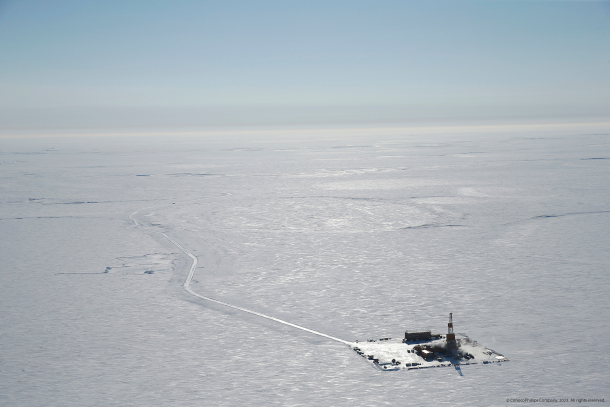
An aerial photo of an exploration pad for ConocoPhillips’ Willow Project. (Photo: courtesy of ConocoPhillips)
A major plan by oil giant ConocoPhillips to drill in Alaska’s North Slope is poised to move ahead after preliminary approval by a federal agency, though it still needs President Biden’s final consent. The potentially lucrative Willow drilling project on federal land could dump millions of tons of climate disrupting carbon into the atmosphere over its lifetime and pose risks to the health of nearby Alaska Native communities and biological diversity. Andy Moderow is Alaska State Director for the Alaska Wilderness League and joins Host Steve Curwood to discuss.
Transcript
CURWOOD: From PRX and the Jennifer and Ted Stanley Studios at the University of Massachusetts Boston this is Living on Earth. I’m Steve Curwood.
President Biden’s campaign pledge to stop extracting fossil fuels from federal lands is facing one of its biggest tests so far. A long-running effort by oil giant ConocoPhillips to drill for oil in a reserve neighboring the Arctic National Wildlife Refuge was recently given the green light by the federal Bureau of Land Management and awaits Joe Biden’s final approval. The Willow project, as it is known, was initially approved by the Trump Administration and would open the largest new oil field on US public land, with the potential of eventually tapping 3 billion barrels of oil. It would also dump millions tons of climate disrupting carbon into the atmosphere over its lifetime and pose risks to the health of nearby Alaska Native communities and biological diversity. Environmental impact concerns have delayed the project until now, but the recent BLM rulings mean Interior Secretary Deb Haaland and President Biden must decide as soon as March 1st if this Arctic drilling project can proceed. So far the Biden administration has already approved more than 6,000 permits for new oil and gas drilling on federal public lands, outpacing the first two years of the Trump administration. Some see a credibility gap between those new permits and Mr. Biden’s pledge to end new oil and gas leasing as part of his agenda to reduce US carbon emissions by 50 percent in the next 7 years. Andy Moderow is Alaska State Director for the Alaska Wilderness League and joins me now from Anchorage. Welcome to Living on Earth!
MODEROW: Thank you. Thanks for having me.
CURWOOD: So this is a big project, Andy; just how big? How much oil are we talking about here? How much in the way of greenhouse gas emissions are we talking about?
MODEROW: Yeah, the project would have 287 million metric tons of carbon emitted during the lifecycle of the project. That's equivalent to 76 US coal plants burning for one year, about a third of the coal plants in our, in our country. So it's a step backwards to unleash that in the region. On top of that, ConocoPhillips has told investors that it doesn't stop at Willow with just 600 million barrels of oil, but they've also identified 3 billion barrels in the region that could also be produced in decades to come, and that they've designed the project for expansion. So we're actually talking about more than just Willow -- a massive project in and of itself -- but also potential expansion in decades to come. And that's what has us really concerned.
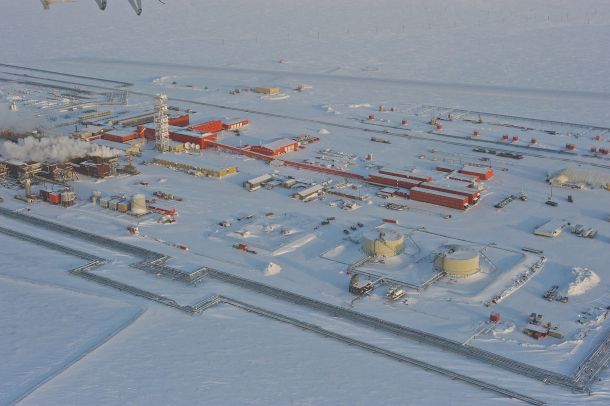
ConocoPhillips’ existing oil fields in the Greater Kuparuk Area of Alaska’s North Slope. (Photo: courtesy of ConocoPhillips)
CURWOOD: Now, some make the argument that the Willow project is located in something known as the National Petroleum Reserve, next to the Arctic National Wildlife Refuge, with this land set aside as a petroleum reserve many presidencies ago, and hey, it's a petroleum reserve, it should be extracted. Your response?
MODEROW: Yeah, so the history of this landscape, it was actually a naval petroleum reserve, founded about 100 years ago, when securing a supply of oil for boats was important. Clearly, times have changed. The administrations that have come actually changed the management of the region, to include preserving the surface values, and making certain that preservation of land is also a critical consideration. We also see this White House realizing we can't keep extracting oil, and finding new oil to extract if we're going to solve this climate crisis. So while the area has a variety of management obligations, we believe that that's been fulfilled by the oil and gas development that's taken place to date in the region. And the oil should be reserved, it needs to be reserved for our climate, in the ground. So that's the position we're taking on that. And the name does not reflect the obligation of the agency in how they manage it today.
CURWOOD: Now, along with the huge climate implications of this, there are important local, human and ecological impacts as well. Talk to me about some of those.
MODEROW: Yeah, the region of the NPR-A that we're talking about is a very wet area, with lots of wetlands and streams and rivers that support a variety of life, ranging from caribou herds that are some of the last unimpeded land migrations we have in North America, through migratory bird routes, that see birds that travel all around the country, and come up to Alaska seasonally. So there's a lot of life in the region. There's also the community of Nuiqsut, which is basically getting surrounded right now by development projects. And if the project moves forward, they've expressed concern, both the city of Nuiqsut and the native village of Nuiqsut, that there are subsistence concerns for how they gather their traditional foods. There's health concerns, air quality concerns, road concerns. Just last year, the community of Nuiqsut had some very scary times when a oil and gas well blew out and released uncontrolled emissions into the air. And still today, we have questions about what happened there. The state is actually charged with looking into incidents like that. And they keep pushing off a public hearing to consider impacts and consider issues related to that release. So that is one of the issues at play here as well. Even though I will add that, you know, no population is a monolith, right. And Alaska Native communities do rely on the income from development. But the community closest to development has been pretty outspoken lately about their fears and concerns about this issue. So that's another thing that the Biden administration really needs to take seriously, as they weigh this decision in the final days.
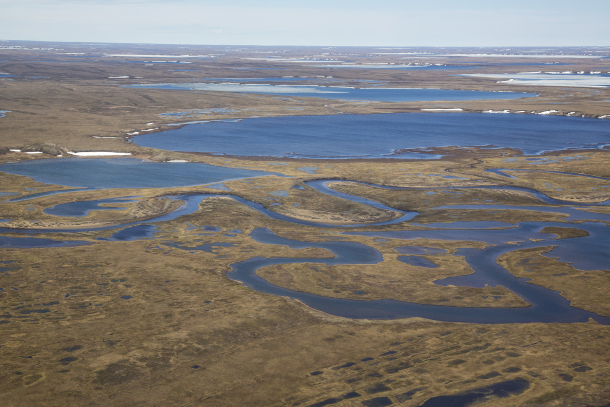
The wetland landscape of the National Petroleum Reserve – Alaska, where the Willow oil drilling project is proposed to be developed (Photo: Bob Wick, BLM)
CURWOOD: How much is this worth to ConocoPhillips to develop? What kind of money are we talking about here?
MODEROW: I think Conoco expects to make a great deal of profits off this project. And what we've seen in recent years with high oil prices, in part due to the war in Ukraine, is that oil companies are making tens of billions of dollars. And so the cost of development of the project is about $8 billion. But if you, you know, look forward, I think they see a potential big asset on their balance sheet.
CURWOOD: And what about the revenues to the people of Alaska and the federal government under the leasing rules?
MODEROW: Yeah, it's a really good question, because the state of Alaska has been on this oil roller coaster, relying too heavily on an extractive industry that's non renewable by definition. Last year, the state of Alaska brought in a little over $3 billion from oil and gas taxes in the state. If you look at Conoco's expectation for the Willow project over 30 years, they estimate the project will bring in about $1.3 billion to the state. That's a little over $40 million a year during the life of the project, about 1% of what the state relies on. So this won't solve Alaska's fiscal crisis if it moves forward.
CURWOOD: What about the social cost of the carbon that's going to be released in this process?
MODEROW: Yeah, the government's own EIS estimates about $20 billion of potential impacts from the carbon if it is released from this project, and you weigh that against the $4 billion the federal government will get, it doesn't seem like a wise investment for the people of this country or for Alaskans. The only investors that this makes sense for is for Conoco's private investors. And that's not how good climate policy should be made.
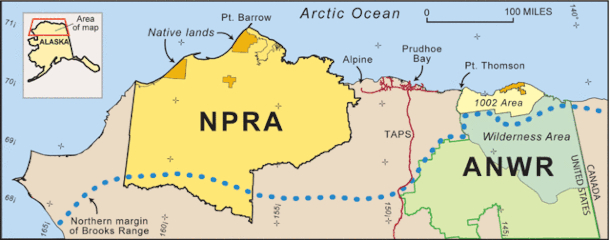
Map of northern Alaska showing location of the National Petroleum Reserve-Alaska, where the Willow Project would be developed, and the Arctic National Wildlife Refuge. (Photo:USGS)
CURWOOD: Now, the window for extracting and burning fossil fuels is rapidly shutting, given that scientists say we must halve greenhouse gas emissions by 2030. I mean, we're talking about just seven years from today. So how realistic are ConocoPhillips' prospects of actually extracting oil there? Or could this be more about say, shorter term interests of the company in being able to put the value of these reserves on their balance sheet?
MODEROW: Yeah, it's a really good question and to put yourself in the shoes of industry right now, you know, there's big questions about the viability of big expensive oil and gas plays. We've seen in the Arctic a bunch of banks, all major US banks, saying they are not interested in Arctic oil. We've seen insurers saying they don't want to insure the infrastructure because it's not worth the risk to their bottom line. I think Conoco is making a bet that when the oil starts being produced seven years from now, if Willow is allowed to move forward, that they'll have a market for that oil. But it could be something more tied to the short term interest on a balance sheet. I think we have to take the threat credibly; Conoco has told the Alaska delegation they want to start building it this winter, and they'll start running bulldozers as soon as they get approval. So I think the threat is real, you know, even if they don't end up developing the full reservoir. If they start building roads, the impacts in the local region will be felt. And so I really do think we have to take this threat seriously.
CURWOOD: Now, what about the argument that maybe half a loaf is okay, that the number of drilling sites that have been discussed could be reduced and therefore have less of an impact. Your read of that argument?
MODEROW: Yeah, thanks for that great question, because we've seen the Biden administration say they're considering a smaller project with three well sites and one deferred. Under President Trump, when the project was approved, it was also just three well sites and then deferrals of future sites. One of the main issues with the environmental analysis to date is that all the action alternatives would basically develop the full reservoir of oil, unleashing the full climate impact, should it be allowed to move forward. There's really not a half Willow on the table. And especially when you couple that with Conoco's stated expansion plans in the future, this is not going to be a small project, no way, shape or form. So it really is why no action is the correct option for our climate.
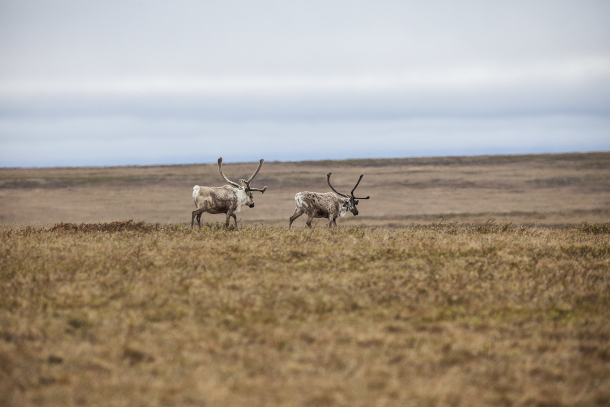
The Teshekpuk Caribou population in the northeast region of the National Petroleum Reserve in Alaska could be impacted by the Willow project. (Photo: Bob Wick, BLM)
CURWOOD: So to what extent are you saying, whether you have one straw in or three or four or five straws into the reservoir of oil there, the oil is going to come out eventually?
MODEROW: Yeah, I mean of the drill sites, if there was just one pad, if they chose the pad with the most oil below it, they have nearly half of the reservoir accessible from one pad alone.
CURWOOD: Now, I'm not an attorney, but looking at a statement that the Interior Department issued on the environmental impact here, it seems that they're not exactly favoring this. How correct is that interpretation?
MODEROW: I really appreciate the nuance you picked up when the Biden Administration released the Willow drilling plan. They stated that they have major concerns about the project in the press release, while also selecting a preferred alternative that would allow it to move forward. And they legally had to select a preferred alternative at that time. But what they signaled in that press release is I think we have an open window right now, the month after they released it or potentially longer to influence the final decision. It's clear the Biden administration is aware of and is considering the negatives and they have concerns about letting Willow move forward. So today and the weeks ahead really are the final call for the American public to get involved here.
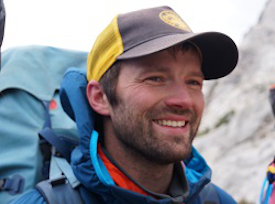
Andy Moderow is Alaska State Director for the Alaska Wilderness League (Photo: courtesy of Andy Moderow)
CURWOOD: Andy Moderow is Alaska State Director for the Alaska Wilderness League. Thanks so much for taking the time with us today.
MODEROW: Thank you, appreciate it.
CURWOOD: We reached out to ConocoPhillips for comment. Dennis Nuss, Director of Media Relations and Crisis Communications for ConocoPhillips, provided a statement that read in part: "We believe this project fits with the Biden Administration’s priorities on environmental and social justice, facilitating the energy transition and enhancing our energy security." The full statement is posted on the Living on Earth website, loe dot org.
Statement from ConocoPhillips
Dennis Nuss, Director of Media Relations and Crisis Communications for ConocoPhillips:
"We believe this project fits with the Biden Administration’s priorities on environmental and social justice, facilitating the energy transition and enhancing our energy security – all while creating good union jobs and providing benefits to Alaska Native communities. Willow has undergone a comprehensive regulatory process for nearly five years with extensive public input, and Alaska Native communities on the North Slope have repeatedly voiced their support for the project. We look forward to a timely Record of Decision to enable this project to move forward in service of the public interest."
When asked about the possibility of expansion beyond the initial 600 million barrels outlined in the Willow Project, Mr. Nuss responded:
"Regarding your question about the 3 billion barrels, the SEIS analyzes the Willow Project, which involves approximately 600 million bbls of production and 180,000 BOPD at its peak. Any potential additional drilling pads would be subject to further NEPA review and analysis."
Links
The Washington Post | “Biden team gives nod to huge Alaska oil project, setting up climate fight”
Letter from the Native Village of Nuiqsut and City of Nuiqsut about Willow project impacts
Anchorage Daily News |"Alaska Native leaders, US senators advocate for Willow oil project"
Alaska Wilderness League on the Willow project
Detailed information from ConocoPhillips on the Willow project
Living on Earth wants to hear from you!
Living on Earth
62 Calef Highway, Suite 212
Lee, NH 03861
Telephone: 617-287-4121
E-mail: comments@loe.org
Newsletter [Click here]
Donate to Living on Earth!
Living on Earth is an independent media program and relies entirely on contributions from listeners and institutions supporting public service. Please donate now to preserve an independent environmental voice.
NewsletterLiving on Earth offers a weekly delivery of the show's rundown to your mailbox. Sign up for our newsletter today!
 Sailors For The Sea: Be the change you want to sea.
Sailors For The Sea: Be the change you want to sea.
 The Grantham Foundation for the Protection of the Environment: Committed to protecting and improving the health of the global environment.
The Grantham Foundation for the Protection of the Environment: Committed to protecting and improving the health of the global environment.
 Contribute to Living on Earth and receive, as our gift to you, an archival print of one of Mark Seth Lender's extraordinary wildlife photographs. Follow the link to see Mark's current collection of photographs.
Contribute to Living on Earth and receive, as our gift to you, an archival print of one of Mark Seth Lender's extraordinary wildlife photographs. Follow the link to see Mark's current collection of photographs.
 Buy a signed copy of Mark Seth Lender's book Smeagull the Seagull & support Living on Earth
Buy a signed copy of Mark Seth Lender's book Smeagull the Seagull & support Living on Earth

